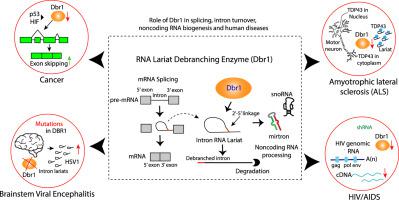Biochimie ( IF 3.9 ) Pub Date : 2020-10-08 , DOI: 10.1016/j.biochi.2020.10.003 Arundhati Mohanta , Kausik Chakrabarti

|
Pre-mRNA processing and mRNA stability play direct roles in controlling protein abundance in a cell. Before the mRNA can be translated into a protein, the introns in the pre-mRNA transcripts need to be removed by splicing, such that exons can be ligated together and can code for a protein. In this process, the function of the RNA lariat debranching enzyme or Dbr1 provides a rate-limiting step in the intron turnover process and possibly regulating the production of translation competent mRNAs. Surprising new roles of Dbr1 are emerging in cellular metabolism which extends beyond intron turnover processes, ranging from splicing regulation to translational control. In this review, we highlight the importance of the Dbr1 enzyme, its structure and how anomalies in its function could relate to various human diseases.
中文翻译:

Dbr1在mRNA加工,内含子更新和人类疾病中起作用
前mRNA加工和mRNA稳定性在控制细胞中蛋白质丰度中起直接作用。在将mRNA转换为蛋白质之前,需要通过剪接除去前mRNA转录本中的内含子,以便将外显子连接在一起并可以编码蛋白质。在此过程中,RNA套索脱支酶或Dbr1的功能在内含子周转过程中提供了一个限速步骤,并可能调节翻译感受态mRNA的产生。Dbr1令人惊讶的新作用正在细胞代谢中出现,其作用范围从内含子转换过程扩展到了从剪接调控到翻译控制的范围。在这篇综述中,我们强调了Dbr1酶的重要性,其结构以及其功能异常与各种人类疾病的关系。


























 京公网安备 11010802027423号
京公网安备 11010802027423号